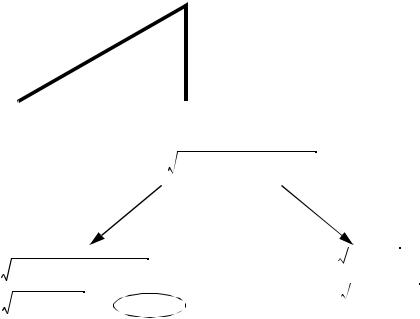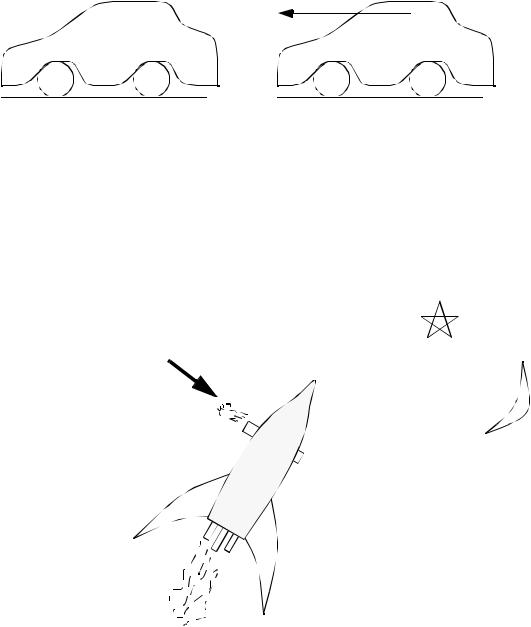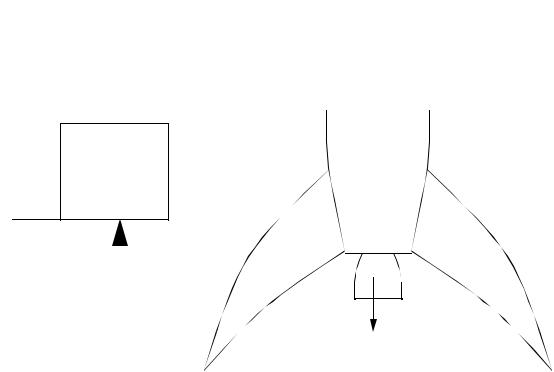
- •1. TABLE OF CONTENTS
- •2. ENGINEERING EDUCATION
- •2.1 PROBLEM SOLVING PHILOSOPHY
- •2.1.1 Tips When Solving Problems
- •2.2 STUDYING ENGINEERING COURSES
- •2.3 THE TOPICS OF MECHANICAL ENGINEERING
- •2.4 CALCULATIONS IN ENGINEERING
- •2.4.1 Units
- •2.4.2 Significant Figures
- •2.5 FUNDAMENTAL THEORIES
- •2.5.1 Newton’s Laws
- •3. THE PROFESSIONAL PRACTICE OF ENGINEERING
- •3.1 ADMINISTRIVIA
- •3.1.1 OBJECTIVES
- •3.1.2 COURSE INFORMATION
- •3.2 THE PROFESSION OF ENGINEERING
- •3.2.1 DEFINITION OF ENGINEERING
- •3.2.2 THE BASIC ELEMENTS OF PROFESSIONAL ENGINEERING
- •3.2.2.1 - Associations and Titles
- •3.2.2.2 - Technical
- •3.2.2.3 - The Professional Practice Examination (PPE)
- •3.2.2.4 - The License
- •3.2.2.5 - Discipline and Enforcement
- •3.2.2.6 - Experience and Character
- •3.2.3 IN GENERAL
- •3.2.3.1 - The Professional Image
- •3.2.3.2 - The Overlap of Engineers and Architects
- •3.2.4 HISTORY OF PROFESSIONAL ENGINEERING IN ONTARIO
- •3.2.4.1 - The Role of The PEO
- •3.3 REFERENCE
- •3.3.1 ENGINEERING ASSOCIATIONS
- •3.4 ETHICS
- •3.4.1 Typical Misconduct Guidelines
- •3.4.2 Typical Ethics Guidelines,
- •3.4.3 Whistle Blowing (aka A Professional Engineers Duty to Report)
- •3.4.4 OLD PPE QUESTIONS FOR PEO
- •3.4.4.1 - Ethics Questions
- •3.4.5 HOW TO APPROACH LAW/ETHICS PROBLEMS
- •3.5 LAW IN GENERAL
- •3.6 BUSINESS LAW
- •3.7 CIVIL LAW
- •3.7.1 CONTRACTS
- •3.7.1.1 - Engineering Contracts
- •3.7.1.2 - Tort Liability and Contract Liability - Concurrently
- •3.7.1.3 - Construction Contracts
- •3.7.1.4 - Liens
- •3.7.2 EMPLOYMENT
- •3.8 CRIMINAL LAW
- •3.8.1 A Duty of Honesty
- •3.8.2 The Combines Investigations Act
- •3.9 REFERENCE
- •3.9.1 ENGINEERING ASSOCIATIONS
- •4. INTELLECTUAL PROPERTY
- •4.1 PATENTS
- •4.2 TRADEMARKS
- •4.3 COPYRIGHT
- •4.4 INDUSTRIAL DESIGN
- •4.5 TRADE SECRETS
- •4.6 REFERENCES
- •5. NEGLIGENCE & LIABILITY
- •5.1 REFERENCES
- •5.2 LAW IN GENERAL
- •5.3 BUSINESS LAW
- •5.4 CIVIL LAW
- •5.4.1 CONTRACTS
- •5.4.1.1 - Engineering Contracts
- •5.4.1.2 - Tort Liability and Contract Liability - Concurrently
- •5.4.1.3 - Construction Contracts
- •5.4.1.4 - Liens
- •5.4.2 EMPLOYMENT
- •5.5 CRIMINAL LAW
- •5.5.1 A Duty of Honesty
- •5.5.2 The Combines Investigations Act
- •5.6 REFERENCE
- •5.6.1 ENGINEERING ASSOCIATIONS
- •5.6.2 Intellectual Property
- •5.6.2.1 - Patents
- •5.6.2.2 - Trademarks
- •5.6.2.3 - Copyright
- •5.6.2.4 - Industrial Designs
- •5.6.2.5 - Trade Secrets
- •5.6.3 TORT/NEGLIGENCE
- •5.7 CANADIAN CASES
- •5.7.1 Alkok v. Grymek
- •5.7.2 Amber Size & Chemical Co. Ltd. v. Menzel
- •5.7.3 Application of Erickson/Massey
- •5.7.4 Armbro Materials and Construction Ltd. v. 230056 Investments Limited et. al.
- •5.7.5 Attorney-General of Canada v. Libling et. al.
- •5.7.6 Bahamaconsult Ltd. v. Kellogg Salada Canada Ltd.
- •5.7.8 Belle River Community Arena Inc. v. W.J.C. Kaufmann Co. et. al.
- •5.7.9 Bethlehem Steel Corporation v. St. Lawrence Seaway Authority
- •5.7.10 Brennan Paving Co. Ltd. v. Oshawa
- •5.7.11 British Reinforced Concrete Engineering Co. Limited v. Lind
- •5.7.13 Calax Construction Inc. v. Lepofsky
- •5.7.15 City of Kamloops v. Nielsen et. al.
- •5.7.16 Conwest Exploration Co. Ltd. et. al. v. Letain
- •5.7.17 Corporation of District of Surrey v. Carrol-Hatch et. al.
- •5.7.18 Croft Construction Co. v. Terminal Construction Company
- •5.7.19 Dabous v. Zuliani et. al.
- •5.7.20 Davis Contractors Ltd. v. Fareham Urban District Council
- •5.7.21 Demers et. al. v. Dufresne Engineering et. al.
- •5.7.22 Derry & Peek
- •5.7.23 Dominion Chain Co. Ltd. v. Eastern Construction Co. Ltd. et. al.
- •5.7.24 Donoghue v. Stevenson
- •5.7.25 Dutton v. Bognor United Building Co. Ltd.
- •5.7.26 Englewood Plumbing & Gas Fitting Ltd. v. Northgate Development Ltd. et. al.
- •5.7.27 Fairbanks Soap Co. Ltd. Sheppard
- •5.7.28 Fern Brand Waxes Ltd. v. Pearl
- •5.7.29 Ford Homes Ltd. v. Draft Masonry (York) Co. Ltd.
- •5.7.30 General Electric Company, Limited v. Fada Radio, Limited
- •5.7.31 GeorgeHo Lem v. Barotto Sports Ltd. and Ponsness-Warren Inc.
- •5.7.32 Grant Smith & Co. v. The King
- •5.7.33 Hadley v. Baxendale
- •5.7.34 Halverson Inc. v. Robert McLellan & Co. et. al.
- •5.7.35 Harbutt’s Plasticine Ltd. v. Wayne Tank and Pump Co. Ltd.
- •5.7.36 Hedley Byrne & Co. Ltd. v. Heller & Partners Ltd.
- •5.7.37 Imperial Glass Ltd. vs. Consolidated Supplies Ltd.
- •5.7.38 Jackson et. al. v. Drury Construction Co. Ltd.
- •5.7.39 John Burrows Ltd. v. Subsurface Surveys Ltd. et. al.
- •5.7.40 Junior Books Ltd. v. Veitchi Co. Ltd.
- •5.7.41 Kamlee Construction Ltd. v. Town of Oakville
- •5.7.42 Kidd v. Mississauga Hydro-Electric Commission et. al.
- •5.7.43 Kocotis v. D’Angelo
- •5.7.44 Lambert v. Lastoplex Chemicals Co. Limited et. al.
- •5.7.45 MacMillan Bloedel Ltd. v. Foundation Co.
- •5.7.46 Markland Associates Ltd. v. Lohnes
- •5.7.47 Metropolitan Water Board v. Dick, Kerr and Company, Limited
- •5.7.48 Monticchio v. Torcema Construction Ltd. et. al.
- •5.7.49 The Moorcock
- •5.7.50 Murray v. Sperry Rand Corporation et. al.
- •5.7.51 Mutual Finance Co. Ltd. v. John Wetton & Sons Ltd.
- •5.7.52 Nedco Ltd. v. Clark et. al.
- •5.7.53 Newman et. al. v. Conair Aviation Ltd. et. al.
- •5.7.54 Northwestern Mutual Insurance Co. v. J.T.O’Bryan & Co.
- •5.7.55 J. Nunes Diamonds Ltd. v. Dominion Electric Protection Co.
- •5.7.56 Owen Sound Public Library Board v. Mial Developments Ltd. et. al.
- •5.7.57 Permutit Co. v. Borrowman
- •5.7.58 Photo Production Ltd. v. Securicor Transport Ltd.
- •5.7.59 Pigott Construction Co. Ltd. v. W.J. Crowe Ltd.
- •5.7.60 Pirelli General Cable Works Ltd. v. Oscar Faber and Partners
- •5.7.61 Pym v. Campbell
- •5.7.62 The Queen et. al. v. Commercial Credit Corp. Ltd.
- •5.7.63 Ramsay and Penno v. The King
- •5.7.64 Regina v. Margison and Associates, Limited
- •5.7.65 Rex v. Bentall
- •5.7.66 Rivtow Marine Ltd. v. Washington Iron Works et. al.
- •5.7.67 Robert Simpson Co. Ltd. v. Foundation Co.
- •5.7.68 Ron Engineering et. al. v. The Queen in right of Ontario et. al.
- •5.7.69 Royal British Bank v. Turquand
- •5.7.70 Salomon v. Salomon & Co. Ltd.
- •5.7.71 Schewebel v. Telekes
- •5.7.72 Sealand of the Pacific Ltd. v. R.C. McHaffie Ltd. et. al.
- •5.7.73 Sparham Souter et. al. v. Town & Country Developments (Essex) Ltd. et. al.
- •5.7.74 Sutcliffe v. Thackrah et. al.
- •5.7.76 Re Thomas Hackett
- •5.7.77 Township ofMcKillop v. Pidgeon and Foley
- •5.7.78 Trident Construction Ltd. v. W.L. Wardrop and Assoc. et. al.
- •5.7.80 Viscount Machine and Tool Ltd. v. Clarke
- •5.7.81 Willard’s Chocolates Ltd. v. Bardsley
- •5.7.82 GLOSSARY
- •5.7.83 OLD PPE QUESTIONS FOR PEO
- •5.7.83.1 - Law Questions
- •5.7.84 HOW SOLVE TO LAW/ETHICS PROBLEMS
- •5.7.85 A NOTE TO YOU
- •6. LEARNING AND TEACHING
- •6.1 LEARNING IN GENERAL
- •6.1.1 Learning Theories
- •6.1.2 References/Bibliography
- •6.2 ON-LINE LEARNING
- •6.2.1 Relevant WWW Sites
- •6.2.2 References/Bibliography
- •7. THE ENVIRONMENT
- •7.1 ENVIRONMENTAL PROTECTION AGENCY (EPA)
- •7.2 LEGISLATION
- •7.2.1 Clean Air Act (CAA) 1970
- •7.3 OCCUPATION SAFETY AND HEALTH ADMINISTRATION (OSHA)
- •7.4 PRACTICE PROBLEMS
- •8. SYSTEM DESIGN
- •8.1 SYSTEM FAILURE
- •8.1.1 Introduction
- •8.1.2 The Theory of Module Reliability and Dependability
- •8.1.3 The Theory of System Reliability
- •8.1.4 Design For Reliability (DFR)
- •8.1.4.1 - Passive Redundant
- •8.1.4.2 - Active Redundant
- •8.1.4.3 - Hybrid Active
- •8.1.4.4 - Other Design Points
- •8.1.5 Formal Methods For Failure Modelling
- •8.1.5.1 - Event Trees
- •8.1.5.2 - Fault Trees
- •8.1.5.3 - Causes Trees
- •8.1.6 Error Sources
- •8.1.7 Risk Control During Design
- •8.1.7.1 - Failure Modes and Effects Analysis (FMEA)
- •8.1.7.2 - Critical Items List (CIL)
- •8.1.7.3 - Failure Modes, Effects, and Criticality Analysis (FMECA)
- •8.1.7.4 - Hazard Causal Analysis (HCA)
- •8.1.7.5 - Interface Analysis
- •8.1.8 Management of Reliability
- •8.1.8.1 - Preliminary Hazard Analysis (PHA)
- •8.1.9 Implemented Risk Management Programs
- •8.1.9.1 - NASA Safety Methods
- •8.1.10 References and Bibliography
- •8.2 PRACTICE PROBLEMS
- •8.2.1 Design Applications of Risk Management
- •8.2.1.1 - The Space Shuttle Orbiter Control Computers
- •8.2.1.2 - A Mobile Service Robot for the Space Station
- •8.2.2 Case Studies In Failure
- •8.2.2.1 - Apollo 204
- •8.2.2.2 - Apollo 13
- •8.2.2.3 - The Challenger
- •8.2.3 Assignment Problems
- •8.2.4 Glossary
- •8.2.5 References and Bibliography
- •9. FORMULAS
- •9.1 ELECTRICAL RELATIONSHIPS
- •9.2 MECHANICAL FORMULAS

page 12
e.g., Find r,
r |
|
|
1.250” |
|
|
|
|
|
|
|
|
|
|
|
5.5” |
|
|
|
|
|
|
r = ( 5.5in) 2 + ( 1.250in) 2 |
|
|
|
|
what the calculator says |
significant figures |
||||
|
|
|
|
|||
|
= |
30.25in2 + 1.5625in |
r |
= |
30 + 1.6 |
|
r |
|
|
31.6( 31.9) = 5.6in |
|||
r |
= |
31.8125in2 |
= 5.6402571in |
r |
= |
|
|
|
|
||||
the last digits are meaningless
because one dimension is measured as 5.5”
• Basic rules of calculations for engineering,
1.To count the number of significant figures, don’t count zeroes at the start of the number, but do count zeroes at the end.
2.When doing calculations, the number of significant figures should be considered. All numbers and results should have the same number of significant figures, or one/two extra for more accurate numbers.
3.Generally, the final result must have at most the same number of significant figures as the least significant number.
4.Typical engineering numbers have 3 or 4 significant figures as they are determined from real systems experimentally.
5.Be aware that different operations may increase or decrease accuracy.
6.Engineers use engineering notation for numbers in exponential form, for example 0.0003
should be 0.3x10-3 not 3x10-4.
2.5 FUNDAMENTAL THEORIES
2.5.1 Newton’s Laws
• The fundamental laws,

page 13
1.Inertia - a particle at rest, or moving along a path will continue to sit still, or move in the same direction with a constant velocity, as long as there are no unbalanced forces applied.
v
The car is still, and will stay still, unless pushed, or the wheels exert a force
The car would continue to roll forward once pushed if air did not exert a resistance force
2.Acceleration - The application of a force to a particle will result in an acceleration in the direction of the force, and proportional to the force. The action and reaction forces balance to zero.
F
a small rocket motor at the side, is used for steering
rocket flying through space accelerates sideways when steering motor fired.

page 14
3.Action and Reaction - When a particle exerts a force on another, there is an equal force generated in the opposite direction. hat is action or reaction is relative)
Mass
MR
 Fg
Fg
 FR
FR
 FG
FG (reaction)
(reaction)
 FG (action)
FG (action)
mass is forced out of rocket engine
• Newton’s Law of Gravitational Attraction - basically the force of attraction between two bodies is a function of separation.
page 15
M1M2 |
|
|
|
|
|
|
|
F = G-------------- |
|
|
|
|
|
|
|
r2 |
|
|
|
|
|
|
|
where, |
|
|
|
|
|
|
|
|
G = gravitation constant |
|
|
||||
|
M1, M2 = the two masses |
|
|
||||
|
r = |
the separation distance (between centres) |
|||||
We can rearrange the equation to the form. |
|
|
|||||
GMearth |
|
|
|
|
|
||
Fthing = |
------------------- |
|
|
|
|
|
|
|
Mthing |
|
|
|
|
||
r2 |
|
|
|
|
|
|
|
where, |
|
|
|
|
|
|
|
|
Mearth = the mass of the earth |
|
|||||
|
r = |
the radius of the earth |
|
|
|||
|
Mthing |
= the mass of some thing |
|||||
|
Fthing |
= the force exerted on the thing (and the earth) |
|||||
The more popular form of this equation is, |
|
|
|||||
F = gM |
|
|
|
|
|
|
|
where, |
|
|
|
|
|
|
|
|
|
|
N |
m |
ft |
||
|
|
|
----- |
---- |
---- |
||
|
g = 9.81kg |
= 9.81 |
2 = 32.2 |
s |
2 |
||
|
|
|
|
s |
|
|
|
page 16
READ |
PROBLEMS |
|
|
|
|
|
SUGGESTED |
REQUIRED |
|
|
|
SLI 1.1-1.6 |
1 to 9 |
|
|
|
|
